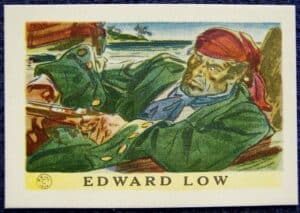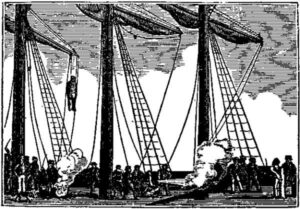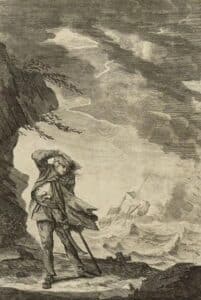“Thus these inhumane wretches went on, who could not be contented to satisfy their avarice only, and travel in the common road of wickedness; but, like their patron, the Devil, must make mischief their sport, cruelty their delight, and damning of souls their constant employment. Of all the piratical crews that were ever heard of, none of the English name came up to this, in barbarity. Their mirth and their anger had much the same effect, for both were usually gratified with the cries and groans of their prisoners; so that they almost as often murdered a man from the excess of good humor, as out of passion and resentment; and the unfortunate could never be assured of safety from them, for danger lurked in their very smiles.”

Early Years
Edward “Ned” Low was born in Westminster, London, according to good ol’ Captain Charles Johnson, the most famous and enigmatic source on all things pirates, although not necessarily the most reliable. Baptismal records show that baby Edward, the son of Richard and Mary Low, was baptized in Saint Margaret’s Church on October 7, 1688, so his birth likely took place in later September or early October.
Ned Low, as he was more commonly referred to, came from a family of habitual lawbreakers – thieves, villains, and scallywags the lot of ‘em, and it wasn’t long before he joined their ranks. Or, as Captain Johnson put it – “nature seem’d to have designed him for a pyrate from his childhood.”
Education played almost no part in Ned’s life. He could neither read nor write. Instead, he spent his childhood picking pockets, robbing, gambling, and fighting anyone who tried to stand up to him.
Ned had at least two brothers, but we are only informed of the eldest one, Richard Low, Dick to his friends. As a young boy, Dick developed a clever way to pickpocket people by hiding in a basket on the shoulders of an accomplice and swiping hats and wigs of passers-by. When he got older, Dick Low teamed up with two other men named Hall and Bunce and together they began burglarizing houses in London before being caught in 1707 and sentenced to hang. According to the Newgate Calendar, a popular record of executions carried out at Newgate Prison, all three men went to the gallows on December 17, 1707.
It is likely that Ned Low wasn’t present for his brother’s execution. In his late teens – early 20s, Low took to the sea, sometimes accompanied by his other brother whose name we don’t know. After about three or four years of this, he made it to the New World and settled in Boston where he worked in a rigging house.
As far as we know, Ned Low only returned to England one more time to see his mother. It was a short visit because he fully intended to build a new life for himself in America. Back in Boston, he had already met a woman named Eliza Marble, and the two got married at the First Church in Boston on August 12, 1714. Random fun fact: they were married by Reverend Benjamin Wadsworth, the future President of Harvard College.
By all accounts, it seems that Low tried to leave his old ways behind and walk the straight and narrow in Boston. He went to church, he had a steady job that paid well, and he intended to start a family. He was more Ned Flanders than Ned Low at this point, but fate did its darn diddliest to make him stray from the righteous path.
Eliza gave birth to a boy sometime during the mid-1710s, but he died in infancy. Then, in 1719, she gave birth to a daughter named Elizabeth. Although the girl survived, Eliza did not, triggering a downward spiral for Low who became angrier and drunker and more violent. Eventually, this cost him his job as a rigger. He still had a baby to support, though, so Low found whatever work he could. Specifically, a voyage to the Bay of Honduras aboard a sloop to collect a shipment of logwood.
This could have been an easy gig, but Low was still seething inside and needed just one more push to finally make him snap. He got it one night when the captain ordered the men to forego dinner to go carry one last shipment. In a hangry mood, Low picked up a musket and fired at the captain. He missed, instead hitting some other poor schmoe, but the action had the desired effect on the crew. A dozen of them mutinied and sailed off in the boat, determined to become pirates. The following day, they captured a sloop better suited to their needs, “went on board her, hoisted a black flag, and declared war with the whole world.”
From Pirate to Pirate Captain

From Honduras, Low and his new crew sailed to the Cayman Islands where they had a fortuitous encounter with another pirate named George Lowther who enticed Ned Low to enter a partnership together – sail with Lowther aboard his ship the Happy Deliverance and share in the spoils. Low and his ragtag gang of misfits happily accepted, but the better question was why would Lowther even offer such a beneficial deal to begin with? He had all the advantages – he was a more experienced captain, he had a bigger ship and a bigger crew. He could have plundered the smaller sloop if he wanted. He could have forced Low and his men to join up, or he could have even killed them. Instead, he offered not only a partnership but even made Ned Low his first mate and took him on as a protégé.
Why exactly Lowther would be so magnanimous we can’t say, but since his early years are completely unknown, some have speculated that he and Low already knew each other. Maybe from London, maybe from Boston, or maybe they served on the same ship years earlier. Whatever the case might have been, Low spent the first half of 1722 as Lowther’s second-in-command, conducting raids in the Caribbean and learning the tricks of the trade.
Then, on May 28, 1722, the pirates captured a brigantine bound for Boston and both captain and first mate agreed that Low had studied enough under Lowther’s learning tree. So Ned Low took a crew of 44 men, “two Guns, four Swivels, six Quarter-Casks of Powder” aboard the captured ship and became its new captain, setting off to seek his own fortunes.
Now the captain of a decent pirate vessel with a proper crew, Ned Low left the Caribbean and instead opted for New England, capturing his first solo prizes off the coast of Rhode Island. However, he didn’t stay long because the governor dispatched two sloops after him when he heard there were pirates in his waters. Low kept heading north, reaching Nova Scotia where he found a delicious prize served on a silver platter to him in Port Rosemary. There were 13 ships in the harbor, but none were equipped for fighting. Low raised the black flag and demanded a complete surrender, warning that any resistance would be met with no quarter. All of them capitulated peacefully and were plundered, and Low even kept the biggest one of all, an 80-ton schooner, for himself. He renamed it the Fancy and made it his new flagship, while his second-in-command, Charles Harris, took charge of his old brigantine.
Low was a man who didn’t like to overstay his welcome in a particular area and, instead, travel far and wide in search of new targets. After he was done with North America, he sailed across the Atlantic to the Azores, then towards Africa near Cabo Verde, and then back across the ocean off the coast of South America. During this time, he captured multiple ships without much hassle since the threat of violence was enough to deter most of them. He changed his flagship again, this time to a pink he named the Rose.
Those who did try to stand up to Low were punished severely, such as was the case with a Captain Carter of the Wright Galley who “because he showed some inclination to defend himself, was cut and mangled in a barbarous manner. There were also two Portuguese friars, whom they tied to the foremast, and several times let them down before they were dead, merely to gratify their own ferocious dispositions…After he had plundered this vessel… they cut her cables, rigging, and sails to pieces, and sent her adrift to the mercy of the waves.”
On another occasion, Low captured a Portuguese ship, only to discover that the captain threw a bag full of gold coins into the sea rather than have it fall into pirate hands. He didn’t take the news well – “Upon this intelligence, Low raved and stormed like a fury, ordered the captain’s lips to be cut off and broiled before his eyes, then murdered him and all his crew.”
Defeat & Disappearance

By 1723, Ned Low was the most feared pirate in the Atlantic and it looked like he had no intention of slowing down. His next rampage took place around the Leeward Islands in the Caribbean, where “he successively captured no less than nineteen ships of different sizes, and in general, treated their crews with a barbarity unequaled even among pirates.”
But success breeds complacency, and Low got too cocky. He had two ships in his command at this stage, having lost or sunk the others – the Fancy and the Ranger. One day, he thought he had spotted his next target – a helpless Royal Navy vessel named the HMS Greyhound, commanded by Captain Peter Solgard. But the Greyhound wasn’t helpless at all. In fact, it was a 20-gun man-o-war prowling those waters in search of Ned Low.
Upon seeing the two pirate ships, the Greyhound began retreating, prompting them to give chase. This, however, was a trap, and Low sailed right into it, with the Fancy receiving a complementary broadside of cannons just as his men were getting ready to board. Both pirate ships turned to flee, and now it was time for the Greyhound to give chase. Eventually, a fortuitous shot destroyed the mainmast of the Ranger, leaving Harris and his men at the mercy of the Royal Navy.
Low, instead of turning back to help, decided to abandon them and escape to safety in the Fancy, with “his behavior throughout this whole action showed him to be a base cowardly villain; for had Low’s sloop fought half so briskly as Harris’ had done (as they were under a solemn oath to do,) the man-of-war… could never have hurt them.”
Captain Solgard took Charles Harris and the other captured pirates to Rhode Island where they were all tried and hanged in July 1723. Meanwhile, Low continued with his cruel ways, if anything becoming more sadistic than ever after suffering, as far as we know, the only defeat of his piratical career. The first vessel that had the misfortune of running into the Fancy was a fishing boat from Nantucket, captained by one Nathan Skiff. Despite surrendering, Low cut off his ears and shot him in the head before sinking the whaler.
The captain of another ship had his entrails ripped out, while another had his ears cut off and was forced to eat them with pepper and salt. Low’s savagery got so extreme that his men started refusing to comply with some of his orders and they weren’t exactly innocent angels, either.
In fact, it’s possible that Low’s excessive cruelty might have been his undoing. We say “possible” because we’re not sure what happened to him. Some claim that the crew finally had enough of Ned Low and mutinied after he murdered his quartermaster while he slept. They marooned him, only to have Low rescued by a passing French vessel. However, once they realized who he was, the French took Ned Low to Martinique where he was hanged for piracy.
Captain Johnson offers no information on his fate. He wrote that Ned Low continued plundering ships off the coast of North America before doing the same in the Caribbean, and once he returned to South America, near Brazil, there was no more news of him or his ship. It’s possible that he successfully lived out his days in anonymity or, more likely, was sunk by a storm and went down to Davy Jones’ locker, a fitting end to one of the most vicious men ever to sail the seven seas.



